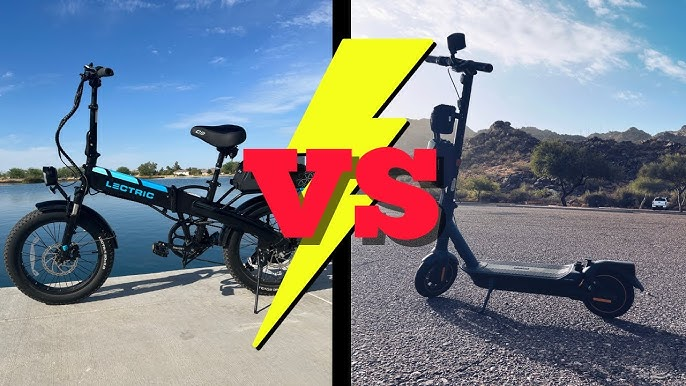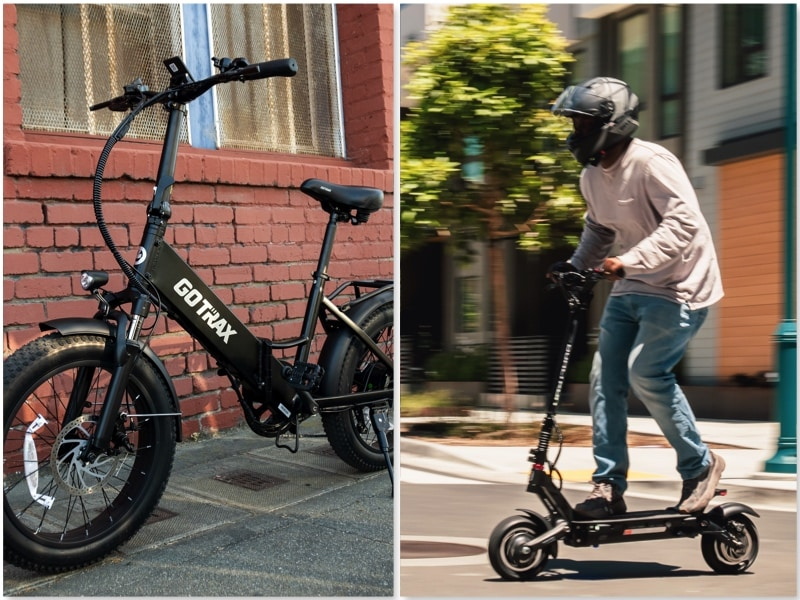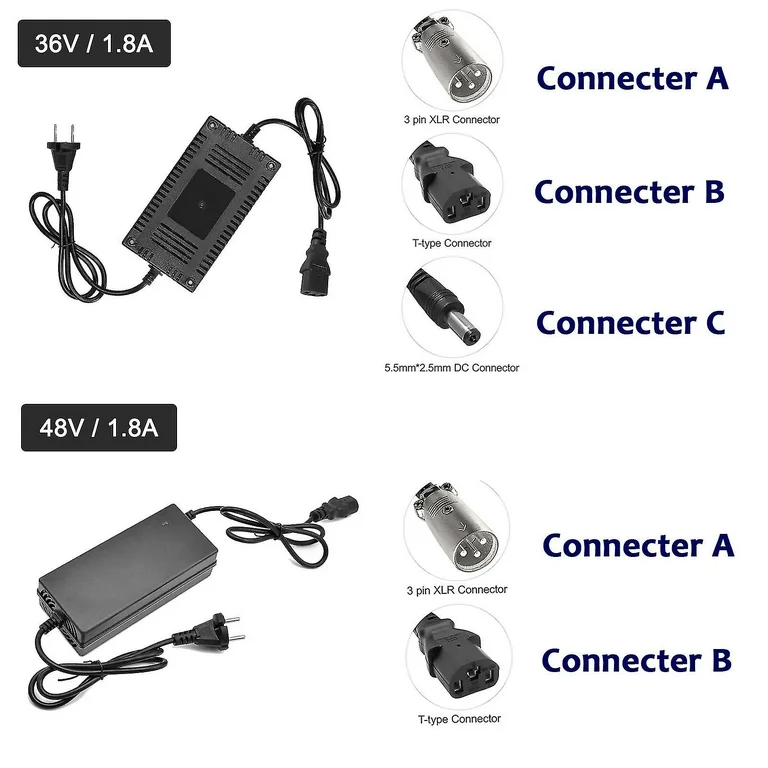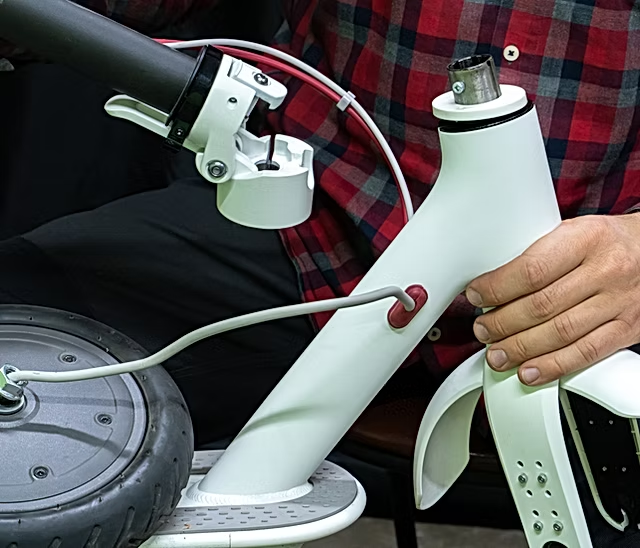As urban mobility continues to evolve, two popular options for quick and eco-friendly transportation have emerged: electric bikes (ebikes) and electric scooters (escooters). What’s the real story? With their increasing availability and growing demand, it’s more important than ever to understand the differences between them to make an informed choice. Whether you’re considering purchasing one for personal use or incorporating them into a business fleet, understanding how ebikes and escooters compare in terms of performance, cost, safety, and convenience can help you make the right decision. Let’s take a deep dive into the world of ebikes and escooters to help you decide which one is the best fit for your needs.
1. What is the difference between an Ebike and an Escooter?
At their core, the differences between an electric bike (ebike) and an electric scooter (escooter) are relatively straightforward. But here’s the kicker… while both are eco-friendly alternatives to cars and buses, their design, usage, and functionality vary in key areas. An ebike is essentially a regular bicycle with an integrated electric motor to assist with pedaling, providing a more traditional, bike-like experience. It comes with pedals, gears, and a saddle, making it ideal for longer rides or commutes.
In contrast, an escooter is a stand-up electric vehicle powered by a motor that directly propels the rider forward. It typically does not require pedaling and operates more like a small electric moped. The structure of an escooter is generally simpler, with handlebars, a platform for standing, and two small wheels.

Key Design Differences
| Feature | Ebike | Escooter |
|---|---|---|
| Power Source | Electric motor + Pedals | Electric motor |
| Design | Bicycle frame with pedals | Stand-up platform with handlebars |
| Speed | 20-28 mph | 15-20 mph |
| Ideal Use | Longer distances, cycling-friendly paths | Shorter, urban commuting |
Understanding these key differences can guide you in selecting the vehicle that aligns best with your needs, whether it’s for leisure, exercise, or practical commuting.
2. How do Ebikes and Escooters compare in terms of speed?
Speed is one of the most noticeable differences between ebikes and escooters. Ready for the good part? Ebikes typically offer higher speeds compared to escooters, especially with their added ability to pedal for extra acceleration. A standard ebike can usually reach speeds of 20-28 mph, depending on the model, terrain, and whether you’re using motor assistance or pedaling.
Escooters, on the other hand, have a lower maximum speed, generally ranging from 15-20 mph. The limitation in speed is partially due to their design, smaller motors, and the fact that they are not intended for extended pedaling.
Speed Comparison
| Vehicle Type | Average Speed | Speed Range |
|---|---|---|
| Ebike | 20-28 mph | Can go faster with pedaling assist |
| Escooter | 15-20 mph | Limited by motor capacity |
While both options offer enough speed for city commuting, if speed is your primary concern, an ebike may be the better choice.
3. What are the range capabilities of Ebikes vs Escooters?
Range—the distance a vehicle can travel on a single charge—is an important consideration when choosing between an ebike and an escooter. What’s the real story? Ebikes typically have a higher range due to their larger battery capacity and the ability to pedal alongside the motor. Most ebikes can travel between 30 to 60 miles on a full charge, depending on battery size, terrain, and the level of assistance used.
Escooters usually have a shorter range, typically ranging from 15 to 30 miles per charge, which makes them ideal for shorter city commutes or quick errands. However, escooters with larger batteries can approach the higher end of that range.
Range Comparison
| Vehicle Type | Typical Range | Ideal Use |
|---|---|---|
| Ebike | 30-60 miles | Long-distance commuting, weekend rides |
| Escooter | 15-30 miles | Short urban trips, quick errands |
If your primary concern is long-range travel, an ebike is likely the better option.
4. Which is more affordable: Ebikes or Escooters?
When it comes to price, here’s the kicker… while both ebikes and escooters can be found at various price points, ebikes generally have a higher upfront cost due to their larger batteries, more complex design, and additional components like gears, pedals, and larger frames. Entry-level ebikes typically start around $500, while high-end models can easily surpass $2,000.
Escooters are usually more affordable, with entry-level models starting at $300 and premium versions ranging between $1,000 and $1,500. The difference in cost can be attributed to the simplicity of escooter designs, fewer components, and less powerful batteries.

Cost Comparison
| Vehicle Type | Starting Price | Premium Models |
|---|---|---|
| Ebike | $500 | $1,500+ |
| Escooter | $300 | $1,500 |
For those on a budget or looking for a more basic model, escooters tend to be the more cost-effective choice.
5. How does the comfort and riding experience compare?
Comfort is another crucial factor when deciding between an ebike and an escooter. This is where it gets interesting… ebikes generally offer a more comfortable experience for longer rides due to their traditional bike design. With a padded seat, handlebars, and the ability to stand or sit, ebikes provide a more customizable and ergonomic riding experience. Plus, the availability of gears allows you to adjust to different terrains more comfortably.
Escooters, however, lack a seat and require the rider to stand throughout the entire ride, which can be less comfortable, especially over longer distances. The small wheels and rigid frame also mean that the ride is bumpier compared to the smoother ride of an ebike, especially when navigating rough or uneven terrain.
Comfort Comparison
| Vehicle Type | Comfort Level | Features |
|---|---|---|
| Ebike | High | Seat, adjustable handlebars, gears |
| Escooter | Medium | Stand-up platform, small wheels |
For longer rides or those concerned with comfort, an ebike is generally the better choice.
6. Which one is better for short vs long commutes?
The ideal vehicle for your commute largely depends on the distance you need to travel. But here’s the kicker… if you’re commuting over short distances, escooters are an excellent choice. They are lightweight, portable, and perfect for hopping on and off public transport or navigating busy city streets. They are easy to store and require minimal maintenance.
For long commutes, ebikes are the clear winner. The ability to pedal along with the motor helps reduce fatigue, and the higher range makes them better suited for longer distances. Ebikes are ideal for users who need to cover significant distances while still benefiting from the electric assistance.
Commute Comparison
| Vehicle Type | Ideal for | Distance |
|---|---|---|
| Ebike | Long commutes | 30-60 miles |
| Escooter | Short commutes | 5-20 miles |
Ebikes are ideal for those who need to travel longer distances, while escooters excel in urban areas with shorter distances.
7. How do Ebikes and Escooters compare in terms of weight?
Weight is a significant factor when considering portability. What’s the real story? Ebikes, due to their larger frames and added components like motors, batteries, and gears, tend to weigh between 40 and 70 pounds. This makes them less portable and harder to carry or store in tight spaces.
Escooters, on the other hand, are much lighter, typically weighing between 20 and 30 pounds. Their compact design and smaller batteries make them easier to carry, especially when navigating stairs or public transport.
Weight Comparison
| Vehicle Type | Weight Range | Portability |
|---|---|---|
| Ebike | 40-70 lbs | Less portable |
| Escooter | 20-30 lbs | Highly portable |
8. What are the legal regulations for Ebikes and Escooters?
When choosing between an ebike and an escooter, understanding the legal regulations in your area is essential. But here’s the kicker… the laws governing the use of ebikes and escooters vary significantly by country, state, and even city. In some regions, both vehicles have similar regulations, while in others, the rules are very different.
In the United States, federal law does not have a unified policy for ebikes and escooters, leaving individual states and municipalities to set their own rules. Some states, like California, have clearly defined laws regarding the use of ebikes and escooters on bike lanes and roads. Meanwhile, some cities restrict where electric scooters can be used, requiring them to be ridden on sidewalks or bike lanes.
In the European Union, ebikes are generally allowed in bike lanes and on public roads, but speed limits are strictly enforced. For example, in Germany, the maximum speed for an ebike is limited to 28 mph, and the rider must be at least 14 years old. Escooters, however, often face stricter regulations. Many cities in Europe require riders to use escooters only on specific streets or paths, and riders must wear helmets and adhere to lower speed limits.

Legal Regulations Overview
| Vehicle Type | Legal Use | Speed Limits |
|---|---|---|
| Ebike | Allowed on bike lanes | 20-28 mph (depending on country) |
| Escooter | Restricted in some areas | Typically 15-20 mph |
Understanding the specific legal requirements in your location can help you avoid fines and ensure safe, legal operation.
9. Which one is safer: Ebikes or Escooters?
Safety is a top concern for anyone considering an ebike or an escooter. What’s the real story? While both vehicles are relatively safe, they come with unique risks. Ebikes tend to be safer due to their larger size and better stability. Their design, with a larger frame and larger wheels, provides more balance and makes it easier to navigate rough terrain. Additionally, since riders can choose to pedal, they have more control over their speed, which can be a crucial safety feature.
Escooters, on the other hand, are more compact and faster to accelerate. The small wheels and the lack of a seat or additional stabilization make them less stable, especially when riding on uneven surfaces. Furthermore, escooters are often used for short, quick trips in busy urban areas, where the risk of collisions and falls is higher.
However, both types of vehicles come equipped with safety features like lights, bells, and reflectors. Some models also have suspension systems that help absorb bumps and provide a smoother ride. That said, riders should always wear helmets, and businesses should ensure that safety features are prioritized for their fleet.
Safety Comparison
| Vehicle Type | Safety Features | Risks |
|---|---|---|
| Ebike | Larger wheels, optional pedaling | Higher speed can cause injury |
| Escooter | Lights, reflectors, bells | Smaller wheels, less stable |
When it comes to safety, ebikes are generally a safer bet, especially for longer or higher-speed rides.
10. Are Ebikes or Escooters more environmentally friendly?
As more people opt for electric vehicles over traditional cars, environmental impact becomes a major factor in their decision-making. This is where it gets interesting… both ebikes and escooters offer a more sustainable alternative to driving, but which one is better for the environment?
Ebikes, with their larger batteries and more complex design, have a higher environmental cost during production but are more energy-efficient over long distances. They also use less energy per mile compared to traditional cars and require less maintenance. Ebikes are particularly eco-friendly for longer trips, as they often replace short car journeys.
Escooters, while more energy-efficient for short trips, are typically used for smaller distances, which may not allow them to make as significant an impact. They are also more likely to be used in urban environments, where emissions are a greater concern. However, their compact design means they consume less energy to manufacture and are lighter to operate, making them a viable eco-friendly option for quick trips.
Environmental Impact Comparison
| Vehicle Type | Energy Consumption | Impact |
|---|---|---|
| Ebike | Efficient for long distances | Higher manufacturing cost |
| Escooter | Low energy usage | Best for short trips |
Both ebikes and escooters contribute positively to reducing carbon footprints, but for long-distance commuting, ebikes are the more eco-friendly choice.
11. Which one is easier to maintain: Ebikes or Escooters?
Maintenance is a crucial factor for anyone looking to purchase an ebike or escooter. Ready for the good part? When it comes to routine maintenance, ebikes generally require more care due to their complex mechanisms. Ebikes have more moving parts, including gears, chains, and brakes, all of which need regular attention. In addition, the battery on an ebike is often larger, which means it may need more frequent care or replacement.
Escooters, on the other hand, have fewer components, making them easier to maintain. They typically don’t require gear adjustments, and most models only need occasional brake checks and tire inflation. However, because many escooters are used on rougher terrain, tire wear can be a significant issue, and some riders may need to replace tires more frequently.
Another important factor in maintenance is the cost. Ebike repairs, such as motor replacements or battery issues, can be expensive. Escooters tend to have lower repair costs due to their simpler design.
Maintenance Comparison
| Vehicle Type | Maintenance Requirements | Cost of Repairs |
|---|---|---|
| Ebike | Gears, chains, battery care | High due to complexity |
| Escooter | Brakes, tires, battery care | Low due to simplicity |
For businesses managing fleets, escooters may be a more cost-effective option for maintenance.
12. How do Ebikes and Escooters compare in terms of maneuverability?
Maneuverability is crucial when deciding which vehicle to choose, especially in busy urban areas with heavy traffic. But here’s the kicker… escooters are typically more maneuverable than ebikes due to their smaller size, lighter weight, and design. With a quick turn of the handlebars, an escooter can navigate tight spaces and avoid obstacles with ease.
Ebikes, while not as nimble as escooters, still offer good maneuverability. Their larger size can make them less agile in dense traffic or on narrow paths. However, their larger wheels provide better stability, especially when riding on uneven surfaces.

Maneuverability Comparison
| Vehicle Type | Maneuverability | Best Use |
|---|---|---|
| Ebike | Moderate | More stability, less agile |
| Escooter | High | Great for tight spaces, urban areas |
If quick, agile turns are a priority, escooters offer superior maneuverability.
13. Which option is better for recreational use: Ebike or Escooter?
When it comes to recreational use, this is where it gets interesting… ebikes are the clear winner for anyone seeking longer, more leisurely rides. The ability to pedal and use the electric motor to assist provides a unique combination of exercise and convenience. Ebikes are also suitable for more rugged terrain, making them ideal for outdoor adventures, whether in the city or on trails.
Escooters, on the other hand, offer a fun, casual way to get around, especially in urban environments. They are perfect for short trips, beach rides, or leisurely rides through the park. However, they may not be as enjoyable for long rides or outdoor exploration due to their limited range and smaller wheels.
Recreational Use Comparison
| Vehicle Type | Ideal Use | Features |
|---|---|---|
| Ebike | Long rides, outdoor exploration | Pedals, more range, stability |
| Escooter | Short trips, urban leisure | Quick, fun, portable |
If you’re looking for an exciting, leisurely ride, an escooter is great for quick urban jaunts, but for outdoor recreation and longer distances, an ebike is the way to go.
14. Can you ride Ebikes and Escooters in the rain or snow?
Weather conditions can greatly affect the performance and safety of both ebikes and escooters. But here’s the kicker… both vehicles are generally not designed for heavy rain or snow, although some models are more weather-resistant than others. Ebikes tend to perform better in wet conditions, especially those designed for off-road use, as they typically feature larger wheels and better stability.
Escooters are more vulnerable in wet conditions due to their smaller wheels and lightweight design. Many escooter manufacturers include waterproofing for the electronics and components, but riding in heavy rain or snow can still cause damage or make the ride slippery and hazardous.
Weather Resistance Comparison
| Vehicle Type | Best Use in Weather | Vulnerabilities |
|---|---|---|
| Ebike | Moderate rain, off-road | Sensitive to heavy snow, ice |
| Escooter | Light rain | Slippery, difficult to control in snow |
If you plan to ride in adverse weather, an ebike is the safer choice, especially if it’s equipped with the proper weather-resistant features.
15. Which one is better for business use or fleet management?
For businesses or fleet managers considering the deployment of either ebikes or escooters, the decision largely depends on the type of service you provide. Ready for the good part? Ebikes are better for long-distance deliveries, with a higher range and the added advantage of being able to travel on bike paths and roads. They’re also more comfortable for drivers, especially on longer routes. However, they are costlier to purchase and maintain.
Escooters are typically more affordable and easier to maintain, making them an attractive option for short-distance services, such as city deliveries or customer rides. They are highly portable, easy to store, and are better suited for businesses in dense urban environments.
Business Use Comparison
| Vehicle Type | Ideal for | Business Benefits |
|---|---|---|
| Ebike | Long-distance services | Higher range, comfortable |
| Escooter | Short-distance services | Affordable, easy to maintain |
Choosing the right vehicle depends on your specific business needs—ebikes are better for long trips, while escooters are ideal for fast, efficient short distances.
FAQ Section
Q1: What is the difference between an Ebike and an Escooter?
An ebike has pedals and a motor, while an escooter is a stand-up, motor-powered vehicle with no pedals.
Q2: Which one has better range: an Ebike or an Escooter?
Ebikes generally offer a longer range, with distances of up to 60 miles per charge, while escooters typically last 15-30 miles.
Q3: Are Ebikes or Escooters more affordable?
Escooters are usually more affordable than ebikes due to their simpler design and fewer components.
Q4: Which one is safer: Ebikes or Escooters?
Ebikes are typically safer due to their larger size and stability, especially on rough terrain.
Q5: Can you ride an Ebike or Escooter in the rain or snow?
Ebikes generally perform better in wet conditions, but both vehicles are not ideal for snow or heavy rain.




